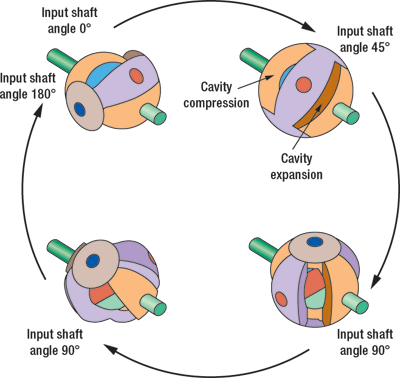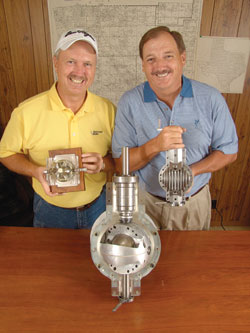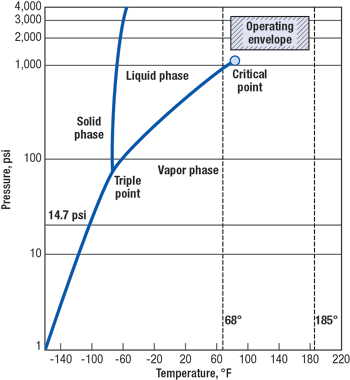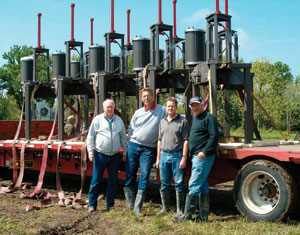Production Technology
Amazing new pump designs achieve remarkable efficiencies
Basic mechanical and chemical principles are applied in new ways to aid low-volume production and multiphase flow.
Victor Schmidt, Drilling Engineering Editor
Occasionally, a bit of technology comes along that is only barely noticed, but over time, changes the world. The rolling cone bit comes to mind as an example. The two pumps featured here might be just as revolutionary. They have been built and tested, are early in their commercial development cycle, but can be purchased or their service licensed today. By all accounts, they work well. Will either of these pumps have a profound impact on the world? Only time will tell, but the potential is there, because these pumps each do something that has never been done before.
They are both positive displacement pumps and both are scalable to meet multiple applications. One of them is a mechanical design of spherical shape. The other pump is a heat-driven, which exploits a modest temperature difference in a highly efficient manner. Their displacements relative to their size are truly amazing. In the near future, these pumps might be found in applications as diverse as the oil field and medical science. They are worth watching as they evolve.
Wedge pump. Some of the neatest devices come in small packages. Like the microchip, this pump is complex and elegant in design, powerful with multiple applications and carries the potential to change its inventor’s chosen application, as well as worlds beyond. The inspiration for this device was the need for an efficient pump to extract natural gas from low-pressure reservoirs.
The Weatherbee Wedge Pump is a spherical mechanical device, invented and developed by Paul and Glenn Weatherbee of W&W Vacuum & Compressors, Inc., in Abilene, Texas. It exploits two basic spherical properties: maximum volume in minimal space and scalability. By applying these principles, the Weatherbees have produced a compact device with the displacement capacity of pumps 10 times its weight and size.
The pump uses two, solid wedge vanes (shaped like two opposing fruit wedges) that spin and oscillate normal to the pump’s axis, Fig. 1. The key to the design is a split-shaft axis, coupled with a carrier ring. Each half-shaft carries one vane. The primary half-shaft carries a vane that rotates around the input shaft’s axis. The secondary half-shaft is stationary and holds the opposing vane. This vane is attached to a center carrier ring and hinged to the primary vane. The carrier ring is set at a 45° angle to the main axis. The angular offset causes the secondary vane to oscillate back and forth on a secondary axis, while being spun around normal to the primary axis and working against the primary vane.
 |
Fig. 1. The Wedge Pump optimizes internal displacement with a four-chambered spherical design.
|
|
This combination motion alternately expands and compresses the wedge-shaped volumes between the vanes. The four-chambered pump acts in some ways like the human heart. It produces four displacement volumes during each cycle (360° axis turn): expanding/ compressing on one side, while compressing/ expanding on the other. Dual input and output ports allow fluid movement through the spaces between the vanes. Its counter-balanced design makes for a quiet, smoothly operating device.
Vane sealing is done with oil-impregnated polyurethane seals along the vane edges for dry gas applications. Seals can be varied to match the production fluids. The pump can be run without seals, if there is liquid in the gas stream, according to Paul Weatherbee, president of W&W (wildcatter@aol.com). The pump has close tolerances and the vanes have thick outer portions that allow a fluid seal to form, while the vanes spin. The device’s efficiency is improved by metering small quantities of oil through the vanes to maintain a fluid seal when pumping dry gas.
One problem with current pumps for low-volume gas wells is that they are hard to adjust for a well’s gas output. Balancing the reservoir’s ability to produce gas and the pump’s efficient operation is often not possible, forcing the operator to shut in the well until wellhead pressure increases.
The wedge pump’s interior displacement is fully controllable with a single throttle lever that allows the pump’s output pressure to be matched to the well’s productive capability without changing the input shaft’s rotation rate. This throttle also permits the pump to completely change pumping direction, when necessary, without altering plumbing connections or adding a reverse-direction pump to the fluid circuit.
The wedge pump is being manufactured in two sizes for oilfield use, 4-in. diameter (25 cu. in. displacement) and 8-1/2-in. (244 cid) diameter, Fig. 2.
 |
Fig. 2. Glenn (left) and Paul (right) Weatherbee display a plastic demonstration pump along with their 4-in. and 8½-in. steel wedge pumps.
|
|
Several wedge pumps are installed on West Texas gas wells and gathering operational data. The pump can be configured as a fluid pump, fluid motor, pneumatic pump, vacuum pump or compressor and its design is protected by numerous patents. The 4-in. gas compressor can handle up to 50 Mcf/d and the 8.5-in. compressor can deliver 300 Mcf/d or more, depending on well inlet pressures.
This pump has the distinction of becoming a possible heart replacement device, among other applications. Doctors at the Texas Heart Institute in Houston, Texas, used a 2-in.-diameter wedge pump to successfully replace a cow’s heart-action during a live-animal trial in August 2004.
Thermal hydraulic engine. This new positive displacement pump is a thermal-hydraulic device that uses the physical properties of liquid carbon dioxide to power a positive displacement pump (see World Oil, November 2004, p. 17). The Natural Energy Engine from Deluge, Inc. (www.delugeinc.com) of Phoenix, Arizona, operates above the CO2 triple point at 87.98°F (31.1°C) and 1,020 psi, where supercritical liquid and gas phases can exist together, Fig. 3. At this temperature and pressure, potential kinetic energy is stored in the CO2’s liquid phase and released by a modest temperature difference. BTU energy throughput efficiencies are very high.
 |
Fig. 3. The thermal hydraulic pump operates over the ranges of 80 – 180°F and 1,500 – 3,000 psi, above the CO2 critical point at 88°F and 1,070 psi.
|
|
The working temperature range of the device is 80 – 180°F. This allows readily available waste heat at 185°F to provide the hot input and well water at 68°F to source the cold side of the system.
One-half gallon of liquid CO2 is held at 1,500 psi, as a working-fluid reservoir. It is then alternately heated and cooled to release the latent kinetic energy. Adding heat increases the reservoir’s internal pressure to 2,500 – 3,000 psi, driven by the liquid’s 30% expansion factor, as it is heated. The expanding liquid CO2 pushes a piston, the only moving part, which acts on the production stream to lift oil and water.
The design is deceptively simple. A 40-ft coil of 1/2-in. heavy-walled stainless steel tubing holds the liquid CO2. The coil is positioned in a container that is alternately filled: first with hot water, then with cold water. From one end of the coil, expanding gas moves the piston, inside the red tubes in Fig. 4, which raises fluids. The pump, sealed by two O-rings on the piston, has a very strong lifting capacity and is scalable for wells up to 12,000-ft deep, according to Brian Hageman, the engine’s inventor and president of Deluge.
 |
Fig. 4. Part of Deluge’s management team readies nine Natural Energy Engines for installation in an oil field outside of Parsons, Kansas.
|
|
The pump acts with modest, but strong, displacements at each stroke. Its smooth cycle is gentle on older reservoirs with diminished natural drives. The volume pull from the pump paces the natural flow of oil through the reservoir’s pore space. This tends to yield a lower water-cut than traditional oilfield pumps, says Hageman.
Because the piston action does not blend multiphase fluids, the pump does not produce excessive emulsions that need breaking, unlike electrical submersible pumps that emulsify oil and water as part of their pumping process. This new device makes high-water-cut wells cheaper to operate by significantly reducing this processing cost. The economic difference can be significant for some fields.
This September, the device won the Outstanding Technology Development Award from the Rocky Mountain Oilfield Testing Center. The pump is installed on wells in Kansas and Wyoming.
Deluge makes the pump available as part of a pumping service/ field development contract and is preparing a licensing agreement for broader application. The pump is patented in the US and in 26 other countries.
DOE help. Both new designs were aided by US Department of Energy (DOE) programs that support new oilfield technology development. W&W’s Wedge Pump was developed using grants through the DOE’s Stripper Well Consortium. Deluge’s Natural Energy Engine was tested at the Rocky Mountain Oilfield Testing Center under a Cooperative Research Development Agreement to build and test a prototype commercial design.
The potential for new, improved tools is never exhausted, as these devices illustrate. No one can guess their ultimate reach, but you will likely see more about these clever designs, as they find their place in the oil field and beyond. 
|






